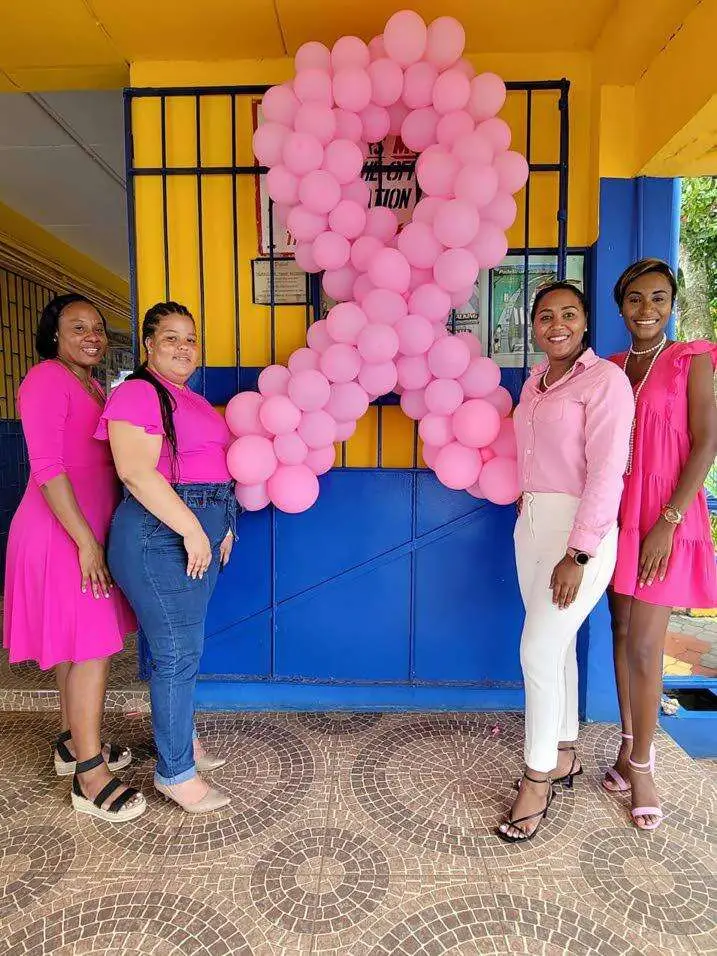
Pink Day at STETHS highlights breast cancer
SANTA CRUZ, St Elizabeth — Cleopatra Young, a literature teacher at St Elizabeth Technical High School (STETHS) here, has every reason to think about the threat posed by breast cancer.
“I have an aunt who is a survivor… so I know about it,” Young told the Jamaica Observer recently by telephone, as she spoke about her role in influencing the commemoration of Breast Cancer Awareness Month on Friday, October 21 at STETHS.
On that day, a significant percentage — perhaps a majority — of the school’s students and staff wore pink, the colour closely linked to cancer awareness. They had fun posing for commemorative photos, and very crucially, attended an awareness session on the disease which is said to be the most common cancer affecting women globally.
Also, as explained by English language teacher Denecia Salmon, students and teachers made small monetary contributions … “what they could afford” towards programmes carried out by the Jamaica Cancer Society. At day’s end, $70,000 was collected, Salmon told the Observer.

According to the World Health Organization (WHO), “In 2020, there were 2.3 million women diagnosed with breast cancer and 685 000 deaths globally. As of the end of 2020, there were 7.8 million women alive who were diagnosed with breast cancer in the past five years, making it the world’s most prevalent cancer.”
A little-known fact is that breast cancer is also a danger to men. The WHO says approximately 0.5 per cent to one per cent of breast cancer cases are male.
In Jamaica, health experts say hundreds of women die annually from breast cancer. One study showed 1,634 breast cancer-related deaths among Jamaican women between 2010 and 2014, accounting for 24 per cent of all female cancer deaths.
Yet, health specialists say the disease can be treated and lives saved, if the signs are caught early. Most lumps in the breast are not cancerous, experts say. However, those and other “abnormalities” should be medically examined as soon as they are noticed.
But that requires knowledge and awareness. According to Salmon, a discussion about how to help in building that awareness among students was how it came about that Young suggested a specific day to commemorate breast cancer awareness at the school.

Young also came up with the idea of ‘Pink Day’. It turned out to be October 21, with students and staff urged to wear pink clothing of some sort.
Young, Salmon, Tannika Johnson, and Kayanna Bent-Foster, all teachers, coordinated in first seeking permission from school principal Keith Wellington and subsequently, organising the awareness day at very short notice.
The well-established male aversion to the colour pink was recognised as a hurdle. As it turned out, many among the male population turned up in pink shirts and even pink strips on their shoes.
“Oh Wow!” was Salmon’s response to questions about how the day went. “The students were so excited to wear pink [despite the short notice]… it was a real buzz,” she said.
At the awareness session conducted by the school nurse, male students were “appalled” to discover, among much else, that men are also susceptible to breast cancer, she said.
Sixteen-year-old Ky-Mani Bowes, a lower-sixth student told the Observer he had no pink clothing to wear on the day. However, he spoke of his admiration when another male student wore a pink shirt with the emblem “Tough men wear pink”.
Bowes became very aware of cancer — not just breast cancer — when a friend, a student at the all-girls’ school Hampton died from the ailment last year.
“When you lose someone to cancer, you understand the effect it has,” he said.
The teenager lamented that much loss of life and grief could be prevented, but “Jamaicans are even afraid to go to the doctor”.
Initiatives such as ‘Pink Day’ at STETHS should become a regular feature across the country, so the public knows of the dangers posed by cancer and the need for medical screening, he said.
“Everything can become so much easier and cheaper if you catch it (cancer) early,” Bowes added.
For Young, ‘Pink Day’ at STETHS was an opportunity to “make learning relevant” for students, helping them “to deal with reality”.
It also provided an opportunity for the school community to celebrate “survivorship” from cancer and the many severe challenges life will throw at them.
“We didn’t just do this for them to walk around in pink,” she said.
Wellington hailed ‘Pink Day’ as a great opportunity to “build social awareness” and suggested it could become an annual event at STETHS. He argued that school can’t only be about academics but should help students to appreciate the issues affecting wider society and also “help them to move out of their shells”.























